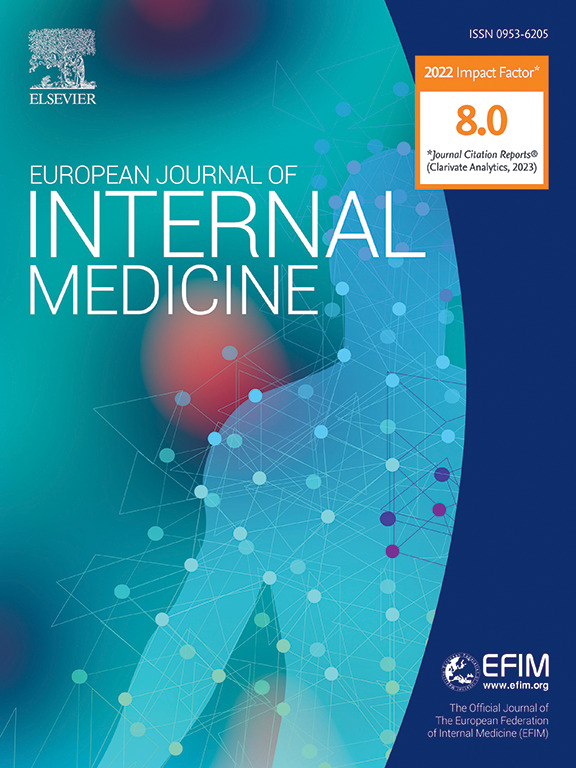社区获得性急性肾损伤风险因素的前瞻性研究。
IF 5.9
2区 医学
Q1 MEDICINE, GENERAL & INTERNAL
引用次数: 0
摘要
背景与假设:社区获得性急性肾损伤(CA-AKI)的原因和风险因素尚未得到深入研究。本研究旨在探讨社区获得性急性肾损伤的风险因素:在这项前瞻性研究中,我们检查了一家大学医院急诊科(ED)在 11 个月内所有就诊者的血清肌酐,以确定是否存在根据 KDIGO 标准定义的 AKI。AKI患者受邀参加。随机抽取的对照组(1:2)根据年龄、性别和入院日期配对。参与者回答了有关病史和用药(包括非处方药)的问题。条件逻辑回归用于确定与 AKI 相关的因素:在602例AKI病例中,有512例参与了研究。与对照组相比,AKI 病例在急诊室就诊前一周使用非甾体类抗炎药(NSAIDs)(26.0% vs 18.0%,p = 0,001)的几率明显更高,尤其是非处方药 NSAIDs(23.3% vs 15.9%,p < 0.001)。AKI 与近期的呕吐(OR 2.52 [95 %CI 1.87-3.39])、腹泻(1.30 [1.00-1.70] )和尿潴留(1.92 [1.36-2.72] )病史、使用非选择性非甾体抗炎药(1.84, [1.1.53[1.13-2.08]),以及糖尿病史(1.42[1.04-1.94])、慢性肾脏病史(1.36[1.01-1.83])和吸烟史(1.72[1.24-2.37]):结论:与合并症相比,急性病和用药(包括非处方药非甾体抗炎药)在 CA-AKI 的发病中可能起更大的作用。频繁使用非处方药物非甾体抗炎药令人担忧,鉴于其严重的不良反应,应引起重视。本文章由计算机程序翻译,如有差异,请以英文原文为准。
Prospective study of risk factors for community-acquired acute kidney injury
Background and hypothesis
Causes and risk factors for community-acquired acute kidney injury (CA-AKI) have not been thoroughly studied. The aim of this study was to examine the risk factors for CA-AKI.
Methods
In this prospective study, we examined serum creatinine from all individuals visiting a university hospital's emergency department (ED) over an 11-month period for the presence of AKI defined according to the KDIGO criteria. Patients with AKI were invited to participate. Randomly selected controls (1:2) were paired according to age, sex, and date of admission. Participants answered questions about their medical history and medication use, including over-the-counter (OTC) drugs. Conditional logistic regression was used to identify factors associated with AKI.
Results
Of 602 AKI cases identified, 512 participated in the study. AKI cases were significantly more likely than controls to have used nonsteroidal anti-inflammatory drugs (NSAIDs) (26.0 % vs 18.0 %, p = 0,001) in the week preceding the ED visit, particularly OTC NSAIDs (23.3 % vs 15.9 %, p < 0.001). AKI was associated with a recent history of vomiting (OR 2.52 [95 %CI 1.87–3.39]), diarrhea (1.30 [1.00–1.70]) and urinary retention (1.92 [1.36–2.72]), use of non-selective NSAIDs (1.84, [1.37–2.48]), RAAS blockers (1.63 [1.21–2.19]), and diuretics (1.53 [1.13–2.08]), and a history of diabetes (1.42 [1.04–1.94]), CKD (1.36 [1.01–1.83]) and smoking (1.72 [1.24–2.37]).
Conclusions
Events in the setting of acute illness and medication use, including OTC NSAIDs, may play a greater role in the development of CA-AKI than comorbid conditions. Frequent use of OTC NSAIDs is a concern and should be addressed in view of serious adverse effects.
求助全文
通过发布文献求助,成功后即可免费获取论文全文。
去求助
来源期刊
CiteScore
9.60
自引率
6.20%
发文量
364
审稿时长
20 days
期刊介绍:
The European Journal of Internal Medicine serves as the official journal of the European Federation of Internal Medicine and is the primary scientific reference for European academic and non-academic internists. It is dedicated to advancing science and practice in internal medicine across Europe. The journal publishes original articles, editorials, reviews, internal medicine flashcards, and other relevant information in the field. Both translational medicine and clinical studies are emphasized. EJIM aspires to be a leading platform for excellent clinical studies, with a focus on enhancing the quality of healthcare in European hospitals.

 求助内容:
求助内容: 应助结果提醒方式:
应助结果提醒方式:


